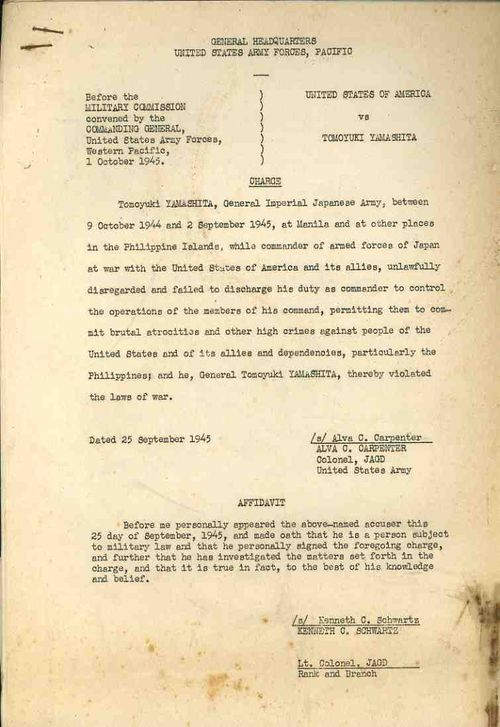JF Ptak Science Books
Before the Military Commission Convened by the Commanding General, United States Army Forces, Western Pacific, 1 October 1945 / Charge / United States of America vs Tomoyuki Yamashita. Offset printed, stapled bound. 13x8".In two sections, composed of 27 leaves, in two discernible parts.
Section One:
- Charges and affadavit, 2pp
- Press Release concerning General Yamashita, 2pp
- Press release of Defense Counsel Staff, 2pp
- Trial of General Yamashita, list of Prosecutor and assistants, 4pp
- Biographical Notes on General Officers, 2pp
Section Two:
- Bill of Particulars (which has the true depth of the charges against Yamashita), 8pp
- Supplemental Bill of Particulars, 7pp
Scarce.[on hold]
This is a rare offset printing of the statement of charges and “outline of particulars” against the Japanese Imperial Army General Tomoyuki Yamashita (1885-1946), a man accused of war crimes against humanity. After he was captured 2 September 1945, General Yamashita was arraigned principally for failing to control his troops, segments of which had acted brutally in their treatment of residents of captured Singapore and against British Empire soldiers. He was charged with “unlawfully disregarding and failing to discharge his duty as a commander to control the acts of members of his command by permitting them to commit war crimes." This was in direct violation the doctrine of “command responsibility” which was established by the Hague Conventions IV (1907) and X (1907), and—after in re Yamashita—would also become known as the “Yamashita standard”, in which courts clearly accepted that “a commander’s actual knowledge of unlawful actions is sufficient to impose individual criminal responsibility”. Yamashita would be found guilty by the U.S. Military Tribunal and was sentenced to death, for "vengeful actions are widespread offences and there is no effective attempt by a commander to discover and control the criminal acts, such a commander may be held responsible, even criminally liable." It was a death sentence for a crime of omission. (As early as the 6thcentury BCE, Sun Tzu, in his Art of War, stipulated that it was a commander's duty to ensure that his subordinates conducted themselves in a civilized manner during an armed conflict.)
Getting back to the war: after Yamashita captured Singapore in February 1942, accepting the surrender of General Arthur Percival and 100,000+ British Army soldiers, a steel wind policy was instituted, with thousands of people—soldiers and civilians—finding their end at the point of Japanese soldiers’ bayonets.
Chief among the atrocities was the Sook Ching movement, a concerted, pervasive and prolonged ethnic cleansing of Singapore of anti-Japanese “undesirable” elements. Among these groups were included (and this list is taken from a rather good contribution to the dubious Wikipedia): Persons who had been active in the China Relief Fund.
- Rich men who had given most generously to the Relief Fund.
- Adherents of Tan Kah Kee, leader of the Nanyang National Salvation Movement.
- Hainanese, who were believed to be communists.
- China-born Chinese who came to Malaya after the 1937 Sino-Japanese War
- Men with tattoo marks, who were believed to be members of secret societies, specifically Triads
- Persons who fought for the British as volunteers against the Japanese.
- Government servants and men who were likely to have pro-British sympathies, such as Justices of the Peace, and members of the Legislative Council.
- Persons who possessed arms and tried to disturb public safety.
In short, it didn’t take all that much to be considered for elimination, and a long and frozen fear and ruthless hearts-and-minds- campaign was instituted which lasted until the Philippines were finally liberated. And it was for the Japanese actions in the Philippines, and then principally in Manila, that General Yamashita was tried, despite the effects of his long and terrible reach across South East Asia
Most of the British and Australian prisoners incarcerated in Singapore’s Changi Prison would never make it out. Other segments of the POWs would be transported on hell ships for forced slave labor throughout the Japanese Empire. The Siam-Burma death railroad (surfaced in the Pierre Boullee novel The Bridge on the River Kwai) received other portions of these POWs; on that 258-mile railroad upwards of 180,000 Asian slave laborers and 60,000 Allied POWs were put to work in horrific and desperate conditions—90,000 of the Asian and 16,000 of the Allied would be killed during the construction (though many estimates are markedly higher than this). The Sandakan airstrip in North Borneo was another death receptacle of these POWs: 3,600 Indonesian slave laborers and 2,300 Allied POWs were set to work here—only 6 Allied POWs (Australian escapees) survived.
In re Yamashita focused on the Philippines and the battleground that it was turned into by Yamashita, costing the civilian population more than 100,000 lives. Tomoyuki Yamashita was hanged on 23 February 1946 at Los Banos Prison Camp, 30 miles south of the city in which he caused so much misery.





Comments